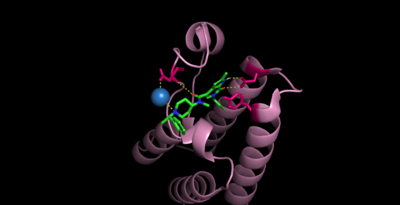User:Elizabeth Cook/Sandbox 1
From Proteopedia
(Difference between revisions)
| Line 6: | Line 6: | ||
== Function == | == Function == | ||
| + | |||
| + | The Cat Eye Syndrome Chromosome Region Candidate 2 (CECR2) is the regulatory subunit of the ATP-dependent CERF-1 and CERF-5 ISWI chromatin remodeling complexes that modulate nucleosome spacing and DNA accessibility during replication and transcription.<ref>PMID:15640247</ref><ref>PMID:22464331</ref><ref>PMID:26365797</ref><ref>PMID:28801535</ref>. CECR2 also plays a key role in the DNA damage repair response, as it inhibits γ-H2AX activity.<ref>PMID:22699752</ref>. CECR2 is involved in various processes during development, including embryogenesis and spermatogenesis.<ref>PMID:22464331,</ref><ref>PMID:26365797</ref>. Recent studies have identified CECR2 as an epigenetic regulator of NF-kB pro-inflammatory gene expression through the recognition of acetylated RelA and driving breast cancer metastasis.<ref>PMID:35108062</ref> | ||
== Domain Organization == | == Domain Organization == | ||
Revision as of 01:55, 29 April 2025
Cat Eye Syndrome Chromosome Region Candidate 2
| |||||||||||
References
- ↑ Herraez A. Biomolecules in the computer: Jmol to the rescue. Biochem Mol Biol Educ. 2006 Jul;34(4):255-61. doi: 10.1002/bmb.2006.494034042644. PMID:21638687 doi:10.1002/bmb.2006.494034042644
- ↑ Banting GS, Barak O, Ames TM, Burnham AC, Kardel MD, Cooch NS, Davidson CE, Godbout R, McDermid HE, Shiekhattar R. CECR2, a protein involved in neurulation, forms a novel chromatin remodeling complex with SNF2L. Hum Mol Genet. 2005 Feb 15;14(4):513-24. Epub 2005 Jan 7. PMID:15640247 doi:http://dx.doi.org/ddi048
- ↑ Filippakopoulos P, Picaud S, Mangos M, Keates T, Lambert JP, Barsyte-Lovejoy D, Felletar I, Volkmer R, Muller S, Pawson T, Gingras AC, Arrowsmith CH, Knapp S. Histone recognition and large-scale structural analysis of the human bromodomain family. Cell. 2012 Mar 30;149(1):214-31. PMID:22464331 doi:10.1016/j.cell.2012.02.013
- ↑ Flynn EM, Huang OW, Poy F, Oppikofer M, Bellon SF, Tang Y, Cochran AG. A Subset of Human Bromodomains Recognizes Butyryllysine and Crotonyllysine Histone Peptide Modifications. Structure. 2015 Sep 4. pii: S0969-2126(15)00329-9. doi:, 10.1016/j.str.2015.08.004. PMID:26365797 doi:http://dx.doi.org/10.1016/j.str.2015.08.004
- ↑ Oppikofer M, Bai T, Gan Y, Haley B, Liu P, Sandoval W, Ciferri C, Cochran AG. Expansion of the ISWI chromatin remodeler family with new active complexes. EMBO Rep. 2017 Oct;18(10):1697-1706. PMID:28801535 doi:10.15252/embr.201744011
- ↑ Lee SK, Park EJ, Lee HS, Lee YS, Kwon J. Genome-wide screen of human bromodomain-containing proteins identifies Cecr2 as a novel DNA damage response protein. Mol Cells. 2012 Jul;34(1):85-91. PMID:22699752 doi:10.1007/s10059-012-0112-4
- ↑ PMID:22464331,
- ↑ Flynn EM, Huang OW, Poy F, Oppikofer M, Bellon SF, Tang Y, Cochran AG. A Subset of Human Bromodomains Recognizes Butyryllysine and Crotonyllysine Histone Peptide Modifications. Structure. 2015 Sep 4. pii: S0969-2126(15)00329-9. doi:, 10.1016/j.str.2015.08.004. PMID:26365797 doi:http://dx.doi.org/10.1016/j.str.2015.08.004
- ↑ Zhang M, Liu ZZ, Aoshima K, Cai WL, Sun H, Xu T, Zhang Y, An Y, Chen JF, Chan LH, Aoshima A, Lang SM, Tang Z, Che X, Li Y, Rutter SJ, Bossuyt V, Chen X, Morrow JS, Pusztai L, Rimm DL, Yin M, Yan Q. CECR2 drives breast cancer metastasis by promoting NF-κB signaling and macrophage-mediated immune suppression. Sci Transl Med. 2022 Feb 2;14(630):eabf5473. PMID:35108062 doi:10.1126/scitranslmed.abf5473
- ↑ Crawford TD, Audia JE, Bellon S, Burdick DJ, Bommi-Reddy A, Cote A, Cummings RT, Duplessis M, Flynn EM, Hewitt M, Huang HR, Jayaram H, Jiang Y, Joshi S, Kiefer JR, Murray J, Nasveschuk CG, Neiss A, Pardo E, Romero FA, Sandy P, Sims RJ 3rd, Tang Y, Taylor AM, Tsui V, Wang J, Wang S, Wang Y, Xu Z, Zawadzke L, Zhu X, Albrecht BK, Magnuson SR, Cochran AG. GNE-886: A Potent and Selective Inhibitor of the Cat Eye Syndrome Chromosome Region Candidate 2 Bromodomain (CECR2). ACS Med Chem Lett. 2017 Jun 1;8(7):737-741. doi: 10.1021/acsmedchemlett.7b00132. , eCollection 2017 Jul 13. PMID:28740608 doi:http://dx.doi.org/10.1021/acsmedchemlett.7b00132

